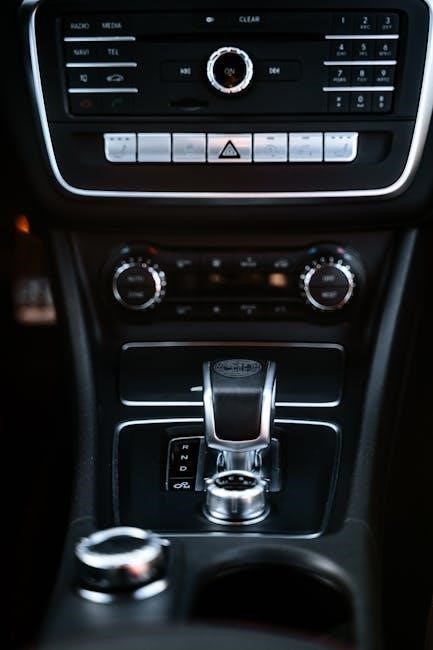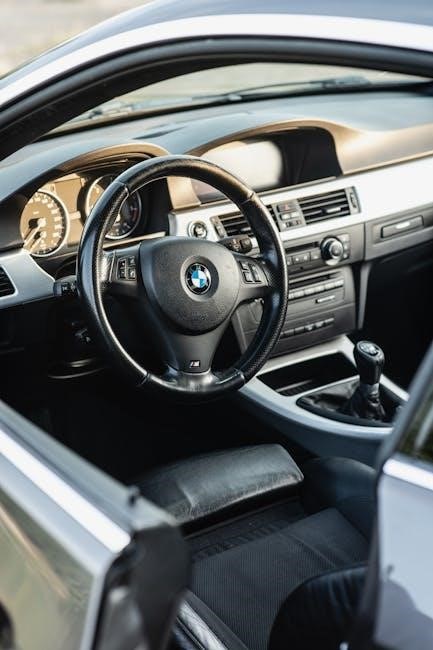of key characteristics and features that set them apart clearly always online․
Overview of Transmission Types
Transmission types are categorized into manual and automatic, with each having distinct characteristics and features․ The main difference lies in the driver’s involvement in gear shifting, with manual transmissions requiring manual shifting using a clutch and gear stick, while automatic transmissions use a torque converter and fluid coupling to shift gears automatically․ Additionally, there are other types of transmissions, such as continuously variable transmissions (CVTs) and automated manual transmissions, which offer a combination of manual and automatic features․ Understanding the different types of transmissions is essential to appreciate their unique advantages and disadvantages, and to make informed decisions when choosing a vehicle․ Furthermore, transmission types can affect fuel efficiency, performance, and driving experience, making it crucial to consider these factors when selecting a transmission type․ Various online resources provide detailed information on transmission types․

History of Manual and Automatic Transmissions
Manual transmissions originated first, with early models emerging in the late 19th century, preceding automatic transmissions by several decades always online clearly․
Evolution of Transmission Technology
The evolution of transmission technology has been marked by significant advancements in recent years, with a focus on improving fuel efficiency and performance․ The development of new materials and technologies has enabled the creation of more efficient and reliable transmissions․ The use of computer-aided design and manufacturing has also improved the quality and consistency of transmissions․ Additionally, the integration of advanced electronics and software has enabled the development of more sophisticated transmission control systems․ This has led to improved shifting performance, reduced fuel consumption, and enhanced driver comfort; The evolution of transmission technology is expected to continue, with ongoing research and development aimed at creating even more efficient and effective transmissions․ This will likely involve the use of advanced materials, such as lightweight composites, and innovative technologies, such as hybrid and electric powertrains, to improve transmission performance and efficiency․

Working of Manual Transmissions
Manual transmissions work using a clutch and gear stick to manually change gears and control speed with a driver coordinated process always online every day․
Manual Transmission Components
Manual transmission components include the clutch, gear stick, and gearbox, which work together to provide a driver-controlled gear shifting experience․ The clutch is a critical component, responsible for connecting and disconnecting the engine from the transmission․ The gear stick, also known as the shift lever, is used to select the desired gear, while the gearbox contains the gears and bearings that facilitate gear shifting․ Additionally, the transmission also includes synchronizers, which help to match the speed of the gears during shifting, and bearings, which support the gears and shafts․ The manual transmission also includes a flywheel, which helps to smooth out the engine’s power delivery, and a pressure plate, which applies pressure to the clutch disc․ These components work together to provide a smooth and efficient shifting experience․ The driver must coordinate the clutch and gear stick to shift gears successfully․

Working of Automatic Transmissions
Automatic transmissions use a complex system of sensors and hydraulic controls to shift gears smoothly and efficiently always using a torque converter and fluid coupling system online․
Automatic Transmission Components
Automatic transmission components include a torque converter, planetary gearset, and hydraulic controls, which work together to provide smooth and efficient gear shifting․ The torque converter is a type of fluid coupling that connects and disconnects the engine from the transmission, allowing the engine to continue running while the transmission shifts gears․ The planetary gearset is a complex system of gears and clutches that provides the various gear ratios needed for different driving conditions․ The hydraulic controls use sensors and solenoids to regulate the flow of fluid and engage the appropriate gears․ These components work together to provide a seamless and efficient driving experience, making automatic transmissions a popular choice for many drivers․ The use of these components allows for a wide range of gear ratios and smooth shifting, making it ideal for various driving conditions and terrains․
Comparison of Manual and Automatic Transmissions
Comparing manual and automatic transmissions involves evaluating their performance, fuel efficiency, and driver control using various
- criteria
and features always online clearly every day․
Pros and Cons of Each Type
Evaluating the pros and cons of manual and automatic transmissions is crucial for making an informed decision․ Manual transmissions offer better fuel efficiency and driver control, but require more driver engagement․ Automatic transmissions provide ease of use and convenience, but may lack the driving experience of manual transmissions․ A list of
- key points
can help compare the advantages and disadvantages of each type, including factors such as performance, maintenance, and cost․ By considering these factors, drivers can choose the transmission type that best suits their needs and preferences, using online resources and
- reviews
to inform their decision and make a confident choice․ Overall, understanding the pros and cons of each type is essential for selecting the right transmission․

Market Trends and Consumer Preferences
Consumers prefer automatic transmissions, with
- sales data
showing a steady decline in manual transmission sales, influencing market trends and production decisions always online clearly․
Shift towards Automatic Transmissions
The shift towards automatic transmissions is evident in the sales data, with a significant decline in manual transmission sales over the years․ According to CarMax’s sales data, there has been a steady decline in manual-transmission buyers every year since 1995․ This trend is expected to continue, with more consumers opting for the convenience and ease of use of automatic transmissions․ The use of
- technology
and
- innovations
in automatic transmissions has also contributed to their increasing popularity․ As a result, manufacturers are producing more automatic transmission vehicles, catering to the growing demand․ The shift towards automatic transmissions is a significant change in the automotive industry, with far-reaching implications for manufacturers, consumers, and the environment, with many factors influencing this change in consumer preference and behavior always online․
